Olympus CAMEDIA D-390 User Manual




 DIGITAL CAMERA
DIGITAL CAMERA
 APPAREIL PHOTO NUMÉRIQUE
APPAREIL PHOTO NUMÉRIQUE
DIGITALKAMERA ENGLISHEn CÁMARA DIGITAL
D-390/C-150 |
FRANÇAIS |
|
|
||
BASIC MANUAL |
DEUTSCH |
|
MANUEL DE BASE |
||
|
||
EINFACHE ANLEITUNG |
ESPAÑOL |
|
MANUAL BÁSICO |
Before using your camera, read this manual carefully to ensure correct use.
We recommend that you take test shots to get accustomed to your camera before taking important photographs.
In the interest of continually improving products, Olympus reserves the right to update or modify information contained in this manual.
For more details on connecting the camera to a PC and installing the provided software, refer to the “Software Installation Guide” (included in the CD-ROM package).
Avant d’utiliser votre appareil photo, veuillez lire attentivement ce mode d’emploi, de manière à obtenir les meilleurs résultats possibles.
Avant d’effectuer des prises de vues importantes, nous vous conseillons par ailleurs de faire quelques essais afin de vous familiariser avec le maniement de l’appareil photo.
Dans l'intérêt d'améliorer continuellement les produits, Olympus se réserve le droit d'actualiser ou de modifier les informations contenues dans ce manuel.
Pour plus de détails sur le raccordement de l’appareil photo à un ordinateur personnel et sur l’installation du logiciel fourni, se référer au “Guide d’installation de logiciel” (inclus dans l’emballage du CD-ROM).
Bitte lesen Sie vor Gebrauch dieser Kamera sorgfältig diese Bedienungsanleitung, um optimale Ergebnisse beim Fotografieren zu erzielen.
Wir empfehlen, vor wichtigen Aufnahmen Probeaufnahmen durchzuführen, um sich mit der Bedienung und den Funktionen der Kamera vertraut zu machen.
Olympus behält sich das Recht vor, im Interesse einer kontinuierlichen Produktverbesserung die in diesem Handbuch enthaltenen Informationen zu aktualisieren und/oder zu ändern.
Weitere Angaben zum Anschluss der Kamera an einen Personal Computer und zum Installieren der mitgelieferten Software siehe die „Software-Installationsanleitung“ (in der CD-ROM-Packung enthalten).
Antes de usar su cámara lea este manual detalladamente para asegurar el uso correcto.
Nosotros le recomendamos que tome fotografías de prueba para familiarizarse con su cámara antes de tomar fotografías importantes.
En el propósito de continuar el mejoramiento de sus productos, Olympus se reserva el derecho de actualizar o modificar la información contenida de este manual.
Para más detalles sobre la conexión de la cámara a un PC e instalación del software suministrado, refiérase a la “Guía de instalación del software” (adjunto en el paquete del CD-ROM).
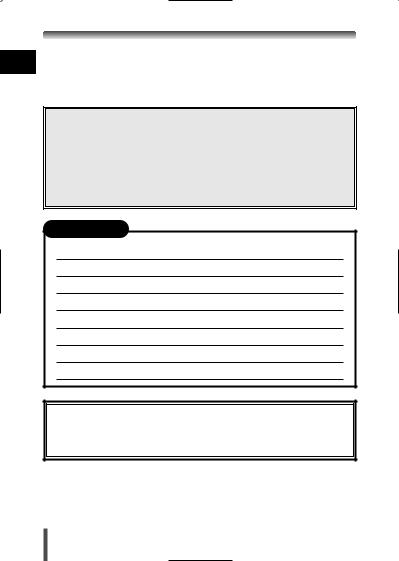
Thank you for purchasing an Olympus digital camera. Before you start to En use your new camera, please read these instructions carefully to enjoy
optimum performance and a longer service life. Keep this manual in a safe place for future reference.
CONTENTS/TABLE DES MATIÈRES/ |
|
INHALT/CONTENIDO |
|
ENGLISH .............................................................................. |
2 |
FRANÇAIS .......................................................................... |
36 |
DEUTSCH .......................................................................... |
70 |
ESPAÑOL ........................................................................ |
104 |
CONTENTS |
|
Getting started |
4 |
Using the menus |
15 |
Shooting |
21 |
Playback |
27 |
Formatting cards |
29 |
Transferring pictures to a computer |
30 |
Error codes |
32 |
Specifications |
33 |
These instructions are only for quick reference. For more details on the camera functions described in this manual, refer to the camera Reference Manual on the CD-ROM enclosed in the camera package.
2
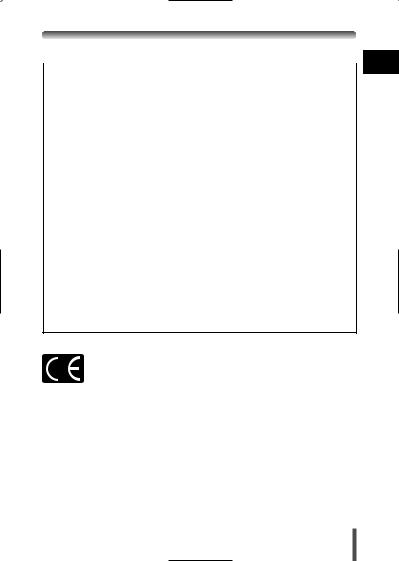
For customers in North and South America
|
|
En |
|
|
|
For customers in USA |
||
Declaration of Conformity |
||
Model Number |
: D-390/C-150 |
|
Trade Name |
: OLYMPUS |
|
Responsible Party |
: Olympus America Inc. |
|
Address |
: 2 Corporate Center Drive, Melville, New York |
|
|
11747-3157 U.S.A. |
|
Telephone Number |
: 631-844-5000 |
|
Tested To Comply With FCC Standards
FOR HOME OR OFFICE USE
This device complies with Part 15 of the FCC rules. Operation is subject to the following two conditions:
(1)This device may not cause harmful interference.
(2)This device must accept any interference received, including interference that may cause undesired operation.
For customers in Canada
This Class B digital apparatus meets all requirements of the Canadian Interference-Causing Equipment Regulations.
For customers in Europe
“CE” mark indicates that this product complies with the European requirements for safety, health, environment and customer protection. “CE” mark cameras are intended for sales in Europe.
Trademarks
•IBM is a registered trademark of International Business Machines Corporation.
•Microsoft and Windows are registered trademarks of Microsoft Corporation.
•Macintosh is a trademark of Apple Computer Inc.
•All other company and product names are registered trademarks and/or trademarks of their respective owners.
•The standards for camera file systems referred to in this manual are the “Design Rule for Camera File System/DCF” standards stipulated by the Japan Electronics and Information Technology Industries Association (JEITA).
3
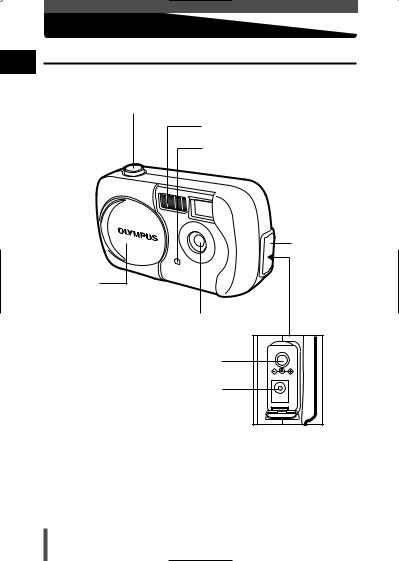
Getting started
Names of parts
En
Shutter button
Flash
Self-timer lamp
Connector cover
Lens barrier
Turns the camera on and off in the shooting mode.
Lens
VIDEO OUT jack
DC-IN jack
4
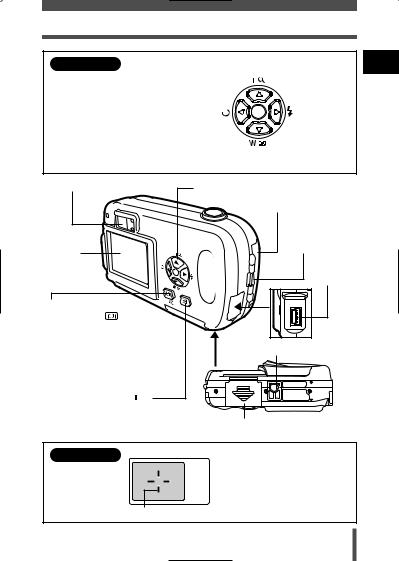
Getting started
Arrow pad |
En |
Simply press a button (Ñ/ñ/É/í) to directly select
zoom in/out, flash or self-timer.
Buttons are also used to Self-timer 
 Flash navigate the various menu
Flash navigate the various menu
items.
Zoom out
Index display
Arrow pad (ÑñÉí)
Card cover
 )
)
the monitor the camera
• connecting the the USB

 )
)
Strap eyelet
USB connector
Tripod socket
Battery compartment cover
Viewfinder
 Orange lamp
Orange lamp
 Green lamp
Green lamp
AF target mark
5

Getting started
Monitor indications
En
●Shooting mode
|
1 |
2 |
|
|
|
3 |
|
|
|
P |
|
|
|
+2.0 |
4 |
|
|
|
|
|
|
|
|
|
7 |
|
|
|
|
|
5 |
|
|
|
|
|
|
6 |
|
|
8 |
|
|
|
|
|
|
|
|
|
|
|
|
|
|
|
9 |
|
|
|
|
|
|
|
HQ |
1600x1200 |
|
|
|||
|
10 |
|
11 |
|
12 |
|
|
|
Items |
|
|
|
|
Indications |
|
1 |
Battery check |
|
|
, |
|
|
|
2 |
Shooting mode |
|
P, |
, |
, |
, |
, |
3 |
Exposure |
|
–2.0 – +2.0 |
|
|
||
|
compensation |
|
|
|
|
|
|
4 |
Spot metering mode |
|
|
|
|
|
5 |
White balance |
, |
, |
, |
|
|
|
|
|||||
|
|
|
|
|
|
|
6 |
AF target mark |
[ ] |
|
|
|
|
|
|
|
|
|
|
|
7 |
Macro |
|
|
|
|
|
|
|
|
|
|
|
|
8 |
Flash mode |
, |
, |
|
|
|
|
|
|
|
|
|
|
9 |
Self-timer |
|
|
|
|
|
|
|
|
|
|
||
10 |
Record mode |
SHQ, HQ, SQ1, SQ2 |
||||
|
|
|
|
|
||
11 |
Resolution |
1600 x 1200, 1024 x 768, |
||||
|
(number of pixels) |
640 x 480, etc. |
||||
|
|
|
|
|
|
|
12 |
Number of storable |
11 |
|
|
|
|
|
still pictures |
|
|
|
|
|
|
Seconds remaining |
11'' |
|
|
|
|
|
for movies |
|
|
|
|
|
6

Getting started
●Playback mode
En
INFO setting allows you to select how much information to display on the monitor. Screens when the information display is set to ON are shown below.
|
1 |
2 |
3 |
|
|
10 |
|
|
x10 |
|
|
|
|
|
|
|
HQ |
4 |
|
HQ |
|
SIZE: 1600x1200 |
5 |
SIZE: 320x240 |
|||
|
|
|
+2.0 |
6 |
|
WB AUTO |
|
|
|
|
7 |
|
|
|
’03.09.12 |
12:30 |
8 |
’03.09.12 12:30 |
||
|
FILE: 100–0020 |
9 |
|
0"/15" 9 |
||
|
Still picture |
|
|
|
Movie |
|
|
Items |
|
|
|
Indications |
|
1 |
Battery check |
|
|
, |
|
|
2 |
Print reservation |
|
x10 |
|
|
|
|
Number of prints |
|
|
|
|
|
3 |
Protect |
|
|
|
|
|
4 |
Record mode |
|
SHQ, HQ, SQ1, SQ2 |
|
||
5 |
Number of pixels |
1600 x 1200, 1024 x 768, |
||||
|
|
|
640 x 480, etc. |
|
|
|
6 |
Exposure |
|
–2.0 – +2.03 |
|
|
|
|
compensation |
|
|
|
|
|
7 |
White balance |
|
WB AUTO, , |
, |
, |
|
8 |
Date and time |
|
'03.09.12 12:30 |
|
||
9 |
File number, Frame |
100-0020, 12, 0"/15" |
|
|||
|
number, Playing time |
|
|
|
||
|
/Total recording time |
|
|
|
|
|
10 |
Movie mode |
|
|
|
|
|
|
• The indications that appear on a movie picture that has been |
|||||
Note |
displayed from the index display are different from those that |
|||||
appear when the movie picture is displayed using the movie |
||||||
|
playback function. |
|
|
|
||
7

Getting started
●Battery check
En
If the remaining battery power is low, the battery check indication on the monitor changes as follows when the camera is turned on or while the camera is in use.
Lights (Green) |
Blinks (Red) |
|
(The indicator turns |
Remaining power level: low. |
|
off after several |
||
Prepare new batteries. |
||
seconds.) |
||
|
||
Pictures can be |
|
|
taken.* |
|
 No indication
No indication
Green and orange lamps on right of viewfinder blink.
Remaining power level: exhausted.
Put in new batteries.
*The amount of energy the camera uses varies greatly on how the camera is operated. Battery power may finish without displaying any warning, causing the camera to turn off.
8

Getting started
Attaching the strap
En
1 Thread the short end of the strap through Strap eyelet the strap eyelet.
• The strap can only enter from the lens side.
2 Thread the long end of the strap through the loop that has already gone through the eyelet.
3 Pull the strap tight, making sure that it is securely fastened and does not come loose.
• Be careful with the strap when you carry the camera, as it can easily catch on stray objects, causing injury or damage.
Note • Attach the strap correctly following the procedure so that the camera does not fall off. If the strap is attached incorrectly and the camera falls off, Olympus is not responsible for any damages.
9

Getting started
Loading batteries
En
Use one CR-V3 lithium battery pack, or two AA (R6) NiMH batteries or alkaline batteries.
Important
•CR-V3 lithium battery packs cannot be re-charged.
•Do not peel the label on a CR-V3 lithium battery pack.
•Manganese (zinc-carbon) batteries cannot be used.
1Make sure that:
•The lens barrier is closed.
•The monitor is off.
•The lamps on the right of the viewfinder are off.
2Slide the battery compartment cover in
the direction of a (the direction |
|
|
|
indicated by the |
mark on the cover), |
|
|
and lift it up in the direction of b. |
b |
a |
|
3 Insert batteries in the direction shown in the illustration.
When using AA (R6) batteries |
When using a CR-V3 lithium battery pack |
There is a mark on the bottom of the camera showing the correct way to insert batteries.
4 Close the battery compartment cover so |
|
||
that it pushes batteries down inside. |
|
||
While pressing the |
mark, slide the |
|
|
cover in the direction of c. |
|
c |
|
• If the battery compartment cover seems hard to |
|||
close, do not force it. With the battery |
|
|
|
compartment cover shut, press the |
mark |
|
|
firmly and push in the direction shown in the illustration.
10
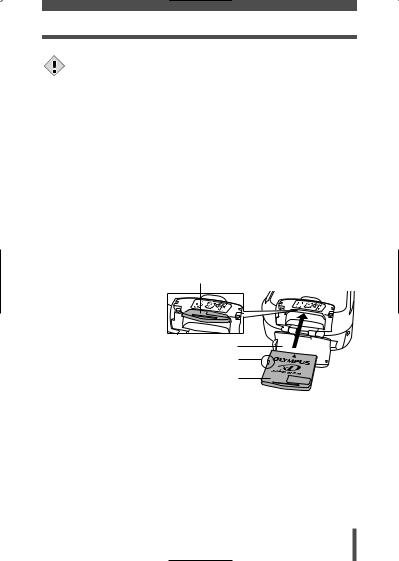
Getting started
• Some camera settings will return to the factory default settings if |
|
En |
the camera is left for about one hour with the battery removed. |
|
|
|
||
Note |
|
|
Inserting/Removing a card |
|
|
“Card” in this manual refers to the xD-Picture Card. The camera uses the |
|
|
card to record pictures. |
|
|
●Inserting a card
1 Make sure that:
•The lens barrier is closed.
•The monitor is off.
•The lamps on the right of the viewfinder are off.
2 Open the card cover.
3 Face the card the correct way and insert it into the card slot as shown.
• Insert the card while keeping it straight.
• When the card is inserted fully, you will feel it lock into place.
• Inserting the card the wrong way or at an angle could damage the contact area or
cause the card to jam.
• If the card is not inserted all the way, data may not be written to the card.
4 Close the card cover.
●Removing the card
1 Make sure that:
2
3
•The lens barrier is closed.
•The monitor is off.
•The lamps on the right of the viewfinder are off.
Open the card cover.
Push the card all the way in to unlock it, then let it return slowly.
•The card is ejected a short way and then stops.
4 Hold the card straight and pull it out.
5 Close the card cover.
11
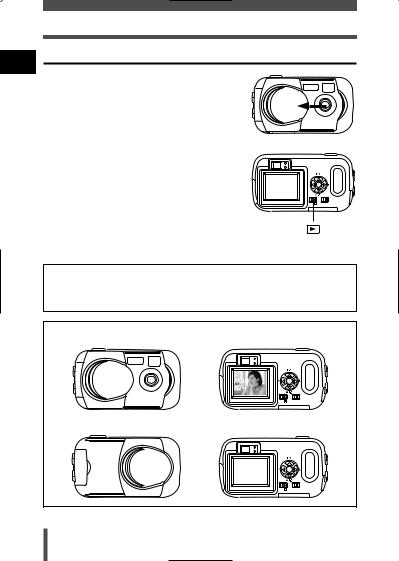
Getting started
Power on/off
En
●When shooting pictures
Power on: Open the lens barrier.
The camera turns on in the shooting mode.
Power off: Close the lens barrier.
The camera turns off.
●When playing back pictures
Power on: Press  with the lens barrier closed.
with the lens barrier closed.
The camera turns on in the playback mode. The monitor turns on and the last picture taken is displayed.
Power off: Press  .
.
The monitor and the camera turn off.
Press  twice quickly (double-click) while in the shooting mode. The camera immediately enters the playback mode and displays the last picture taken.
twice quickly (double-click) while in the shooting mode. The camera immediately enters the playback mode and displays the last picture taken.
● Power on
● Power off
12

Getting started
Selecting a language |
En |
|
You can select a language for on-screen display.
Available languages vary depending on the area where you purchased this camera.
1 |
Open the lens barrier fully. |
Arrow pad (ÑñÉí) |
|
|
|||
2 |
Press |
. |
|
• The top menu is displayed.
3 Press í on the arrow pad to select
MODE MENU.
4 Press Ññ to select the SETUP tab, then press í.
SETUP tab
MODE MENU |
MODE RESET |
Top menu
CAM |
ALL RESET |
ON |
|
PIC |
|
ENGLISH |
|
CARD |
|
ON |
|
REC VIEW |
ON |
||
SETUP |
|||
FILE NAME |
RESET |
5 Press Ññ to select 
 , then press í.
, then press í.
SETUP CARD PIC CAM
ALL RESET  ON
ON



 ENGLISH
ENGLISH  ON
ON
REC VIEW  ON FILE NAME
ON FILE NAME  RESET
RESET
13

Getting started
En 6 Press Ññ to select a language, then
press |
. |
7 Press 
 again to exit the menu.
again to exit the menu.
ENGLISH
FRANCAIS
DEUTSCH
ESPAÑOL
SELECT
 GO
GO

8 Close the lens barrier to turn the camera off.
Setting the date and time 
1 Open the lens barrier fully. 2 Press 
 .
.
• The top menu is displayed.
3 Press í on the arrow pad to select MODE MENU. 4 Press Ññ to select the SETUP tab, then press í. 5 Press Ññ to select  , then press í.
, then press í.
• The green frame moves to the selected item.
6 Press Ññ to select one of the following date formats:Y-M-D
(Year/Month/Day), M-D-Y (Month/Day/Year), D-M-Y (Day/ Month/ Year). Then press í.
•Move to the year setting.
•The following steps show the procedure used when the date and time settings are set to Y-M-D.
7 Press Ññ to set the year, then press í to move to the month setting.
•To move back to the previous setting, press É.
•The first two digits of the year are fixed.
8 Repeat this procedure until the date and time are completely set.
•The camera only displays the time in the 24-hour time system. (“2 pm” would be “14:00”.)
9 Press 
 .
.
•For a more accurate setting, press 
 when the time hits 00 seconds. The clock starts when you press the button.
when the time hits 00 seconds. The clock starts when you press the button.
10 Close the lens barrier to turn the camera off.
14

Using the menus
Menu items
En
When you turn on the camera and press 
 , the top menu is displayed on the monitor. The functions of this camera are set from the menus. This chapter explains the types of menu items that this camera has and how they work, using shooting mode screens.
, the top menu is displayed on the monitor. The functions of this camera are set from the menus. This chapter explains the types of menu items that this camera has and how they work, using shooting mode screens.
Press 
 . The top menu is displayed.
. The top menu is displayed.
MODE MENU |
MODE RESET |
Select a menu using the arrow pad.
Shortcut Menus
•Takes you directly to the setting screen.
•Display operational buttons at the bottom of the screen.
How to use the mode menu
MODE MENU
•Categorizes the settings into tabs.
•Displays the tabs of each menu. Select the desired tab on the left of the screen by pressing Ññ.
1Press 
 to display the top menu. Press í.
to display the top menu. Press í.
2Press Ññ to select a tab, then press í.
3Press Ññ to select an item, then press í.
4Press Ññ to select a setting. Press 
 to complete setting. Press
to complete setting. Press 
 again to exit the menu and return to shooting.
again to exit the menu and return to shooting.
15

Using the menus
Shortcut menus
En
●Shooting mode
Records movies. This icon appears when the menu is displayed in the still picture shooting mode.
 PHOTO
PHOTO
A simple press of the shutter button gives you optimal exposure and focus for general photography. This icon appears when the menu is displayed in the movie recording mode.
Sets the image quality and resolution.
Still picture : SHQ, HQ, SQ1, SQ2
Movie : HQ, SQ
MODE RESET
Restores functions (exposure compensation, white balance, etc.) to the factory default settings. MODE RESET is identical to the ALL RESET function included in the MODE MENU.
●Playback mode
Runs through all saved pictures one after another as a slide show. This icon appears when the menu is displayed while a still picture is played back.
MOVIE PLAY
Plays back movies. This icon appears when the menu is displayed while a movie frame is played back.
16
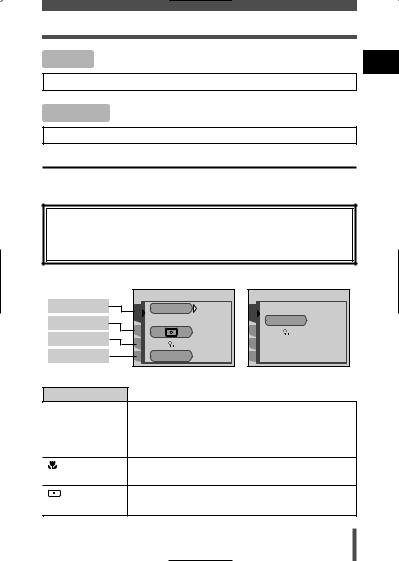
Using the menus
INFO
Displays all the shooting information on the monitor.

 ERASE
ERASE
Erases the selected still picture or movie.
Mode menus
The MODE MENU is divided into tabs. Press Ññ to select a tab and display the associated menu items.
These instructions are only for quick reference. For more details on the camera functions described in this manual, refer to the camera Reference Manual on the CD-ROM enclosed in the camera package.
●Shooting mode
CAMERA tab
PICTURE tab
CARD tab
SETUP tab
CAMERA tab
SCENE SELECT
SET CARD PIC CAMERA
SCENE SELECT |
PROGRAM |
AUTO |
 OFF
OFF
 OFF
OFF
 0.0
0.0
PANORAMA
Still picture
SET CARD PIC CAMERA
 OFF
OFF

 OFF
OFF  0.0
0.0
Movie
Selects the shooting mode from



 (program auto),
(program auto),  (portrait),
(portrait),
 (landscape),
(landscape),  (night scene) or
(night scene) or  (self portrait).
(self portrait).
Allows you to shoot as close as 20 cm (0.7 ft.) to your subject.
Meters light within the AF target mark to determine exposure.
17

|
|
|
|
|
|
|
|
|
|
Using the menus |
|
||||
|
|
|
|
|
|
|
|
|
|
|
|
|
|
|
|
|
|
|
|
|
|
|
|
En |
|
CAMERA tab |
|
||||
|
|
|
|
|
|
|
Adjusts the brightness of the picture. |
|
|
|
|
|
|
|
|
|
|
|
|
|
|
|
|
|
|
PANORAMA |
Allows panorama pictures to be taken with Olympus |
||||
|
|
|
|
|
|
|
CAMEDIA-brand cards. |
|
|
2 IN 1 |
Combines two still pictures taken in succession and |
||||
|
|
|
|
|
|
|
stores them as a single picture. |
|
|
|
|
|
|
|
|
|
|
|
|
|
|
|
|
|
|
PICTURE tab |
|
||||
|
|
WB |
Sets the appropriate white balance according to the |
||||
|
|
|
|
|
|
|
light source. |
|
|
|
|
|
|
|
|
|
|
|
|
|
|
|
|
|
|
CARD tab |
|
||||
|
|
CARD SETUP |
Formats a card. |
||||
|
|
|
|
|
|
|
|
|
|
|
|
|
|
|
|
|
|
SETUP tab |
|
||||
|
|
ALL RESET |
Selects whether to keep the current camera settings |
||||
|
|
|
|
|
|
|
when you turn off the power. |
|
|
|
|
|
|
|
|
|
|
|
|
|
|
|
Selects a language for on-screen display. |
|
|
|
|
|
|
|
|
|
|
|
|
|
|
|
|
|
|
|
|
|
|
|
|
|
|
|
|
|
|
|
Turns the beep sound (used for warnings, etc.) on |
|
|
|
|
|
|
|
and off. |
|
|
|
|
|
|
|
|
|
|
REC VIEW |
Selects whether to display pictures on the monitor |
||||
|
|
|
|
|
|
|
while saving them to a card. |
|
|
FILE NAME |
Chooses how to name files and folders of pictures. |
||||
|
|
|
|
|
|
|
|
|
|
PIXEL MAPPING |
Checks the CCD and image processing functions for |
||||
|
|
|
|
|
|
|
errors. |
|
|
|
|
|
|
|
|
|
|
|
|
|
|
|
Adjusts the brightness of the monitor. |
|
|
|
|
|
|
|
|
|
|
|
|
|
|
|
|
|
|
|
|
|
|
|
|
|
|
|
|
|
|
|
Sets the date and time. |
|
|
VIDEO OUT |
Selects NTSC or PAL according to your TV’s video |
||||
|
|
|
|
|
|
|
signal type. TV video signal types differ depending |
|
|
|
|
|
|
|
on the region. |
|
|
|
|
|
|
|
|
18
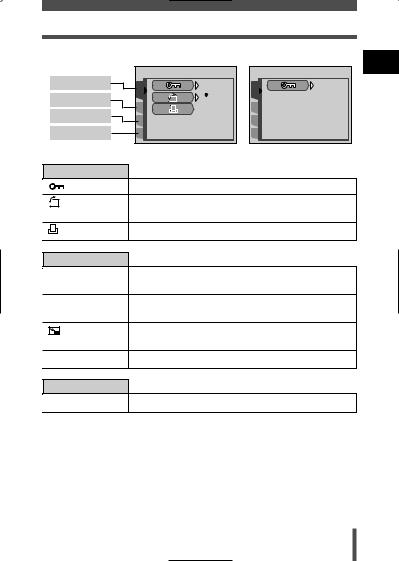
●Playback mode
PLAY tab
EDIT tab
CARD tab
SETUP tab
PLAY tab
EDIT tab
BLACK&WHITE
SEPIA
INDEX
CARD tab
CARD SETUP
Using the menus
En
PLAY |
OFF |
PLAY |
OFF |
0 |
|
||
EDIT |
EDIT |
|
|
|
|
||
CARD |
|
CARD |
|
SET |
|
SET |
|
|
Still picture |
|
Movie |
Protects pictures from accidental erasure.
Rotates pictures 90 degrees clockwise or counterclockwise.
Stores print reservation information on the card.
Creates a black and white picture and saves it as a new picture.
Creates a sepia-toned picture and saves it as a new picture.
Makes the file size smaller and saves it as a new picture.
Creates an index picture of a movie in 9 frames.
Formats the card, erasing all image data stored on it.
19

Using the menus
En |
|
SETUP tab |
|
||||
|
|
ALL RESET |
Selects whether to keep the current camera settings |
||||
|
|||||||
|
|
|
|
|
|
|
when you turn off the power. |
|
|
|
|
|
|
|
|
|
|
|
|
|
|
|
Selects a language for on-screen display. |
|
|
|
|
|
|
|
|
|
|
|
|
|
|
|
|
|
|
|
|
|
|
|
|
|
|
|
|
|
|
|
Turns the beep sound (used for warnings, etc.) on |
|
|
|
|
|
|
|
and off. |
|
|
|
|
|
|
|
|
|
|
|
|
|
|
|
Adjusts the brightness of the monitor. |
|
|
|
|
|
|
|
|
|
|
|
|
|
|
|
|
|
|
|
|
|
|
|
|
|
|
|
|
|
|
|
Sets the date and time. |
|
|
|
|
|
|
|
|
|
|
VIDEO OUT |
Selects NTSC or PAL according to your TV’s video |
||||
|
|
|
|
|
|
|
signal type. TV video signal types differ depending |
|
|
|
|
|
|
|
on the region. |
|
|
|
|
|
|
|
Selects the number of frames in the index display. |
|
|
|
|
|
|
|
|
20

Shooting
Shooting modes
En
This camera shoots still pictures and movies. In the still picture shooting mode, select a shooting mode from  PHOTO (P/
PHOTO (P/ /
/ /
/ /
/ ), depending on shooting conditions and the effect you want. The factory default setting is P (PROGRAM AUTO). You are able to shoot normally even if you do not select a shooting mode.
), depending on shooting conditions and the effect you want. The factory default setting is P (PROGRAM AUTO). You are able to shoot normally even if you do not select a shooting mode.
 PHOTO Still picture shooting
PHOTO Still picture shooting
Lets you take still pictures. You can select a more specific shooting mode depending on the scenes you want to shoot.
 Movie recording
Movie recording
Lets you record movies. You cannot record movies with sound.
Still picture shooting modes
P PROGRAM AUTO (factory default setting)
Used for regular photography. The camera automatically makes settings for natural color balance. Other functions, such as the flash mode, can be adjusted manually.
 Portrait shooting
Portrait shooting
Suitable for taking a portrait-style shot of a person. The camera automatically sets the optimal shooting conditions.
 Landscape shooting
Landscape shooting
Suitable for taking photos of landscapes and other outdoor scenes. The camera automatically sets the optimal shooting conditions.
 Night-Scene shooting
Night-Scene shooting
Suitable for taking photos of landscapes and people in the evening or at night. The camera sets a slower shutter speed than is used in normal shooting. If you
take a picture of a street at night in any other mode, the lack of brightness will
result in a dark picture with the
background underexposed and without Normal shooting and flash on details. In this mode, the true appearance
of the street is captured. The camera automatically sets the optimal shooting conditions. We recommend that you set the flash mode to AUTO.
Night-Scene shooting and flash on
21

Shooting
En |
Self Portrait shooting |
Enables you to take a picture of yourself while holding the camera. Point the lens towards yourself and the focus will be locked on you. The camera automatically sets the optimal shooting conditions.
Selecting shooting modes
1 Open the lens barrier fully. 2 Press 
 .
.
• The top menu is displayed.
3 In the top menu, press í to select MODE
MENU.
• Movie recording: Press Ñ to select  .
.
4 Press Ññ to select the CAMERA tab, then press í.
5 Press Ññ to select SCENE SELECT, then press í.
6 Press Ññ to select a mode from



 ,
,  ,
,  ,
,  or
or  , then press
, then press

 .
.
• Press 
 again to exit the menu.
again to exit the menu.
MODE MENU 
MODE RESET
CAMERA |
SCENE SELECT |
PROGRAM |
|
AUTO |
|||
|
|||
PIC |
|
|
|
CARD |
|
|
|
SET |
PANORAMA |
|
22

Shooting
Taking still pictures using the viewfinder  PHOTO En
PHOTO En
Shutter button
1 Open the lens barrier fully.
2 Compose your picture
while looking at the  Orange lamp image in the viewfinder.
Orange lamp image in the viewfinder.
 Green lamp
Green lamp
AF target mark
3
4
Press the shutter button gently (halfway) to adjust the focus.
•When the focus and exposure are locked, the green lamp lights steadily. (focus lock)
•If the orange lamp lights, the flash fires automatically.
Press the shutter button all the way (fully).
•The camera takes the picture, and a beep sounds.
•When the green lamp stops blinking, you can take the next picture.
•When the orange lamp starts blinking, the pictures are stored on the card.
How to lock the focus
When shooting a hard-to-focus subject, point the camera at an object about the same distance away as the subject. Press the shutter button halfway. Keeping the shutter button pressed halfway, recompose your shot. Press the shutter button fully.
23

Shooting
En Recording movies 
1 Open the lens barrier fully. 2 Press 
 .
.
• The top menu is displayed.
3 Press Ñ to select  .
.
•Movie recording is set and the camera returns to the shooting mode.
•The  mark and the total recordable time depending on the card memory capacity are displayed on the monitor.
mark and the total recordable time depending on the card memory capacity are displayed on the monitor.
4 Decide the composition while looking at the image on the monitor. 5 Press the shutter button halfway.
• The focus is locked.
6 Press the shutter button fully to start recording.
•The orange lamp on the right of the viewfinder lights.
•The camera always sets the best exposure, even if the subject moves.
•During movie recording,  lights red and the time you can shoot is displayed.
lights red and the time you can shoot is displayed.
7 Press the shutter button again to stop recording.
•The orange lamp blinks while the movie is stored on the card.
•When the remaining recording time has been used up, recording stops automatically.
Zoom (Digital zoom)
1 Open the lens barrier fully.
2 Press Ñ.
•The monitor turns on and the zoom bar appears. The subject is magnified by 1.3 times.
3 Press Ññ while looking at the image on the monitor.
•Each time you press Ñ, the zoom magnification changes in the following sequence:
1 time T 1.3 times T 1.6 times T 2.0 times T 2.5 times.
•Each time you press ñ, the zoom magnification changes in the following sequence:
2.5 times T 2.0 times T 1.6 times T 1.3 times T 1 time.
•The zoom magnification changes continuously while holding down Ñor ñ.
4 Take the picture.
24

Shooting
Using the flash |
En |
|
Select the flash mode best suited to the light conditions and the effect you want to achieve.
1 Open the lens barrier fully.
2 Press í (  ).
).
3
4
5
•The monitor turns on.
•The current flash setting is displayed.
Press í again to set the flash mode.
•Each time you press í, the flash mode changes in the following sequence: “AUTO” – “  Red-eye reduction” – “
Red-eye reduction” – “  Fill-in flash” – “
Fill-in flash” – “  Flash off”.
Flash off”.
Press the shutter button halfway.
• When the flash fires, the orange lamp lights steady.
Press the shutter button fully to take the picture.
Auto-flash (No indication)
The flash fires automatically in low light or backlight conditions.
To shoot a subject with backlight, position the AF target mark over the subject.
Red-eye reduction flash (  )
)
The light from the flash may make the subject’s eyes appear red in the picture. The red-eye reduction flash mode reduces this phenomenon by emitting pre-flashes before firing the regular flash. This helps accustom the subject’s eyes to the bright light and minimizes the red-eye phenomenon.
Fill-in flash (  )
)
The flash fires regardless of the available light. This mode is useful for eliminating shadows on the subject’s face (such as shadows from tree leaves), in a backlight situation, or for correcting the color shift produced by artificial lighting (especially fluorescent light).
Flash off (  )
)
The flash does not fire even in low light conditions. Use this mode in situations where flash photography is not desired or is prohibited, such as in an art museum. You can also use this mode when you want to shoot a natural-looking twilight or night scene.
25

Shooting
En |
|
Self-timer shooting |
|
|
|
This function lets you take pictures using the self-timer. Fix the camera |
|
|
|
||
|
|
securely on a tripod or set it on a level surface for self-timer shooting. This |
|
|
|
function is useful for taking pictures where you want to be included in the |
|
|
|
photograph. |
|
|
1 |
Open the lens barrier fully. |
|
|
2 |
Press É ( ). |
|
|
3 |
• The monitor turns on. |
|
|
Press É again to set the self-timer mode. |
||
•The setting changes between  OFF and
OFF and  ON each time É is pressed. When the self-timer mode is selected,
ON each time É is pressed. When the self-timer mode is selected,  is displayed on the monitor.
is displayed on the monitor.
4 Take the picture. Press the shutter button to start the timer and take the picture.
•The self-timer lamp lights for approximately 10 seconds, then starts blinking. After blinking for approximately 2 seconds, the picture is taken.
•The self-timer mode is automatically canceled after one shot.
26

Playback
Viewing still pictures |
En |
|
1 Press  with the lens barrier closed.
with the lens barrier closed.
•The monitor turns on and displays the last picture taken. (Single-frame playback)
2 Use the arrow pad to play back other pictures.
3 Press  to cancel playback.
to cancel playback.
• The monitor and camera turn off.
Displays the previous picture. (É)
Close-up playback (Ñ)
Index display(ñ)
Displays the next picture. (í)
Viewing movies 
1 Press  with the lens barrier closed.
with the lens barrier closed.
• The monitor turns on.
2 Use the arrow pad to display the picture with  . 3 Press
. 3 Press 
 .
.
• The top menu is displayed.
4 Press Ñ to select MOVIE PLAY.
5 Press Ññ to select PLAYBACK, then press 
 .
.
•The movie is played back.
•After playback, the menu is displayed.
PLAYBACK : Plays back the entire movie again.
FRAME BY
FRAME : Plays back the movie manually one frame at a time. EXIT : Leaves the movie playback mode.
Press Ññ to select from PLAYBACK, FRAME BY FRAME or EXIT, then press

 .
.
●When FRAME BY FRAME is selected
Ñ : Displays the first frame of the movie.
ñ: Displays the last frame of the movie.
í: Displays the next frame. The movie can be displayed continuously by holding the button down.
É: Displays the previous frame. The movie can be displayed continuously in reverse by holding the button down.

 : Displays the MOVIE PLAY menu.
: Displays the MOVIE PLAY menu.
27
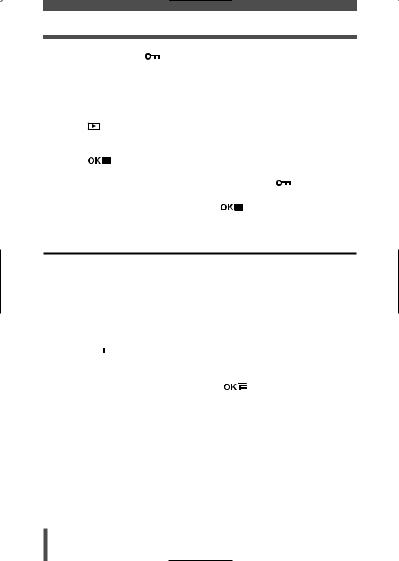
Playback
En |
|
Protecting pictures |
|
|
|
|
||||
|
You are recommended to protect important pictures to avoid accidentally |
|||||||||
|
|
|||||||||
|
||||||||||
|
|
erasing them. Protected pictures cannot be erased by the single-frame/all- |
||||||||
|
|
frame erase function. |
|
|
|
|
||||
|
1 |
Press |
|
with the lens barrier closed. |
|
|
|
|
||
|
2 |
• The monitor turns on. |
|
|
|
|
||||
|
Use the arrow pad to display the picture you want to protect. |
|||||||||
|
3 |
Press |
|
|
. |
|
|
|
|
|
|
|
|
|
|
|
|
||||
|
|
|
|
|
|
|
||||
|
|
|
|
|
|
|
||||
|
|
|
|
|
|
|
||||
|
4 |
• The top menu is displayed. |
|
|
|
|
||||
|
In the top menu, select MODE MENU T PLAY T |
, and press |
||||||||
|
5 |
í. |
|
|
|
|
|
|
|
|
|
Press Ññ to select ON, then press |
|
|
. |
|
|||||
|
|
|
|
|||||||
|
|
|
|
|||||||
|
|
|
|
|||||||
|
|
|
|
|||||||
• To cancel protection, select OFF.
Single-frame erase 

Recorded pictures can be erased. There are two types of erase: Singleframe erase, which erases only the picture that is displayed on the monitor, and all-frame erase, which erases all the pictures on the card.
1 Press  .
.
• The monitor turns on.
2 Use the arrow pad to display the picture you want to erase. 3 Press 
 .
.
• The top menu is displayed.
4 Press ñ to select 

 .
.
5 Press Ññ to select YES, then press |
. |
• The picture is erased and the menu is closed.
28

Playback
All-frame erase |
En |
|
This function erases all the pictures on the card.
1 In the playback mode top menu, select MODE MENU T CARD T CARD SETUP, and press í.
2 Press Ññ to select  ALL ERASE, then press
ALL ERASE, then press 
 .
.
3 Press Ññ to select YES, then press 
 .
.
• All the pictures are erased. Protected pictures are not erased.
Formatting cards (Card setup)
This function lets you format a card. Formatting prepares cards to receive data. Before using non-Olympus cards or cards which have been formatted on a PC, you must format the card with this camera.
All existing data, including protected pictures, are erased when the card is formatted. Make sure that you save or transfer important data to a PC before formatting a used card.
1 In the top menu, select MODE MENU T CARD T CARD SETUP, and press í.
•Shooting mode: The  FORMAT screen is displayed.
FORMAT screen is displayed.
•Playback mode: The CARD SETUP screen is displayed.
2 If the  FORMAT screen is displayed, press Ññ to select YES. If the CARD SETUP screen is displayed, press Ññ to select
FORMAT screen is displayed, press Ññ to select YES. If the CARD SETUP screen is displayed, press Ññ to select 
FORMAT, then press 
 .
.
When the  FORMAT screen appears, press Ññ to select YES.
FORMAT screen appears, press Ññ to select YES.
3 Press 
 .
.
• The BUSY bar is displayed and the card is formatted.
29

Transferring pictures to a computer
By connecting the camera to a computer with the provided USB cable,
En images on a card can be transferred to the computer. Some OS's (operating systems) may need a special setup when connecting to the camera for the first time. Follow the chart below. For details on the procedures in the chart, refer to the “Reference Manual” on the CD-ROM and the “Software Installation Guide” (included in the CD-ROM package).
Identifying the OS
|
|
|
|
|
|
|
|
|
|
|
|
|
|
|
|
||||||
Windows 98/98 SE |
|
Windows 2000 |
|
|
Mac OS 9.0 - 9.1/OS X |
|||||
(Second Edition) |
|
Professional/Me/XP |
|
|
*OS 8.6: See below. |
|||||
|
|
|
|
|
|
|
|
|
|
|
|
|
|
|
|
|
|
|
|
||
Installing the USB |
|
|
|
|
|
|
|
|
||
driver for Windows 98 |
|
|
|
|
|
|
|
|
||
|
|
|
|
|
|
|
|
|
|
|
|
|
|
|
|
|
|
|
|
|
|
|
|
|
||||||||
|
|
|
|
|||||||
Connecting the camera to a computer using the provided USB cable |
||||||||||
|
|
|
|
|
|
|
|
|
|
|
|
|
|
|
|
|
|
|
|
||
|
|
|
|
|
||||||
|
|
|
|
|
||||||
Confirming the computer recognizes the camera |
|
|
|
|||||||
|
|
|
|
|
|
|
|
|
|
|
|
|
|
|
|
|
|
|
|
|
|
|
|
|
|
|
||||||
|
|
|
|
Downloading image files |
|
|
||||
|
|
|
|
|
|
|
|
|
|
|
|
|
|
|
|
|
|
|
|||
|
|
|
|
|
||||||
|
|
|
|
Disconnecting the USB cable |
||||||
|
|
|
|
|
|
|
|
|
|
|
*Even if your computer has a USB connector, data transfer may not function correctly if you are using one of the operating systems listed below or if you have an add-on USB connector (extension card, etc.).
●Windows 95/NT 4.0
●Windows 98/98 SE upgrade from Windows 95
●Mac OS 8.6 or lower (except Mac OS 8.6 equipped with USB MASS Storage support 1.3.5 installed at the factory)
●Data transfer is not guaranteed on a home-built PC system or PCs with no factory installed OS.
You can view images using: graphics applications that support the JPEG file format (Paint Shop Pro, Photoshop, etc.); Internet browsers (Netscape Communicator, Microsoft Internet Explorer, etc.); CAMEDIA Master software; or other software. For details on using commercial graphics applications, refer to their instruction manuals.
30
